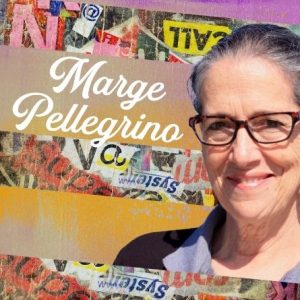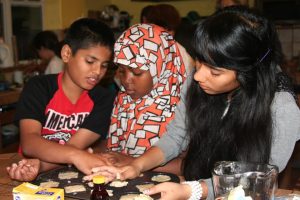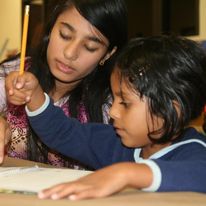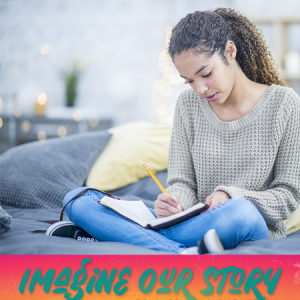Meet Marge Pellegrino—the Library's current Writer In Residence
Local author Marge Pellegrino, opens a new window has a long history of working in and around Pima County Public Library. For years, she organized Owl & Panther’s expressive arts programming for refugee survivors and Word Journeys at the Woods Memorial Library. She has created innovative programming for youth and adults, and has spoken at the library about the many books she has written for kids and teens. She is this summer’s Writer In Residence and I spoke with her about her library endeavors.
What is the Writer In Residence program, who is it for and how is it structured?
The Writer-in-Residence program is an opportunity to talk one-on-one with an established writer about one’s own writing project and one’s curiosity about writing. It’s for novice as well as seasoned writers. People will spend a half hour virtually with me to talk about whatever they are working on.
Tell me the kind of questions you are asked and the kind of help you provide.
Sometimes people read to me from their work to get feedback or have questions about generating new work. They ask a wide gamut of questions from how to structure their writing to how to get published. Soup to nuts. Writing is an accessible art form for everyone and I’m here to help make this art happen for people. Whatever people want, I am there for them.
You brought expressive arts to Owl & Panther in 1998. How did that collaboration come about and why did you choose expressive arts as the vehicle for young folks to process and integrate their experiences of trauma?
My involvement with Owl & Panther, opens a new window came about because of the library. I was already doing my expressive arts program Word Journeys when I was asked by the Tucson Writer’s Project to interview someone at a local refugee clinic. I was intrigued and inspired by the youth component of the work at the clinic, so much so that when I came back to the library, we applied for a grant. This grant funded my first two years at Owl & Panther.
As an aside, the Tucson Writer’s Project was my introduction to writing and started my 43-year relationship with the library. They taught me how to write. I remember a workshop with Barbara Kingsolver in the basement of the Main Library and I remember a workshop at Himmel where I created the poem that was my first to be published.
What I noticed with Word Journeys and eventually Owl & Panther was the big difference it made to work with youth over time rather than just in a onetime session. Kids were able to build skills, feel safe and feel at ease to share. I noticed this for the first time in an exercise where youth retold the O’odham folk tale, ‘How the rattlesnake got its fangs.’ It was an ‘aha’ moment for me; they expressed the tale in a way that matched their personality and personal experiences. Telling the tale empowered them and allowed them to get out of themselves. Putting art and writing on the page like this allowed them to re-frame their experience. Creating the art was really about creating themselves.
How did your experience working with survivors of torture and trauma, and your experience in expressive arts, influence the creation of your many books?
After my first two books, my writing came directly from my refugee work. My writing was me trying to understand what happened to these kids. They longed for their homeland and often missed the person that they were. Journey of Dreams, opens a new window is my investigation of what it is that sends these kids so far from home. It is a compilation of the people I knew and the stories of the young folks I met. My hope for the book is that it gives American kids a window into why that kid is sitting next to them in class and how they got there.
The Sculpture Speaks, opens a new window came from my visit to Southside Presbyterian and the story of the sculpture there. It is about the power of the expressive arts to heal, and how hearing just one story, or telling just one story, can change everything for you. My latest, Neon Words: 10 Brilliant Ways to Light Up Your Writing, opens a new window, is everything I have learned about writing and everything that excites me about writing. It takes the reader through various writing exercises, techniques, and styles to connect the word-organizing part of their brain with their free-ranging imagination.
You are leading a writing workshop for teens this summer. What do you hope to accomplish? How will you achieve your goals?
I just finished presenting a teen creative writing workshop with the Arizona State Museum where the youth wrote about border walls. I learned a lot about presenting workshops virtually. I hope that the teens will have fun and sharpen their skills. It’s a good setting for them to exercise their brain in a different way and hear what each other has to say.
I will offer them prompts and they will gather quotes from the internet on different themes and engage with the writing they find. I will offer different tools based on who is in the group and offer something for everyone based on their interests. The workshop will be dynamic in this way, and develop naturally over time. We’re going to have fun and use writing as a tool for thinking.
What are you most looking forward to about the workshop?
Getting people excited about writing and offering a safe place where, even if you are unsure of yourself, you will be ok.
Your workshop is part of the library’s summer project for youth, Imagine Our Story, opens a new window, where tweens and teens will attend workshops and submit art and writing reflecting on some of what they experienced this last year and some of what they hope and imagine for the future. From your perspective, describe the value of this program to youth and to the community.
The pandemic is an epic time. The personal art and writing that we engage in can transform us. It helps us make sense of this time and build our resilience. The ways we learn to adapt can inform how we adapt going forward. When we share our stories we learn from each other.
Writing gives us a chance to take our grief outside of ourselves. We put in on the page, acknowledge it and share it. We can then engage with it in a way that doesn’t hurt so much. Writing can be transformative. It gives us power over our grief.
In this project, not only will youth get a chance to create, they may see their work published. This builds confidence. Seeing their work online gives youth a good feeling because it opens up the opportunity that their work will influence and even inspire other people. It’s also a resume builder that youth can cite when they are applying for college or in any of their future endeavors.
How can people get involved with what you are doing this summer?
Folks can go to the Writer In Residence, opens a new window page and sign up for a one-on-one session or register for the June 19 Cows are Going to Paris event. Youth can go to the Imagine Our Story, opens a new window page and apply to attend the writing workshop.
You can read more about Marge Pellegrino on the Writer In Residence, opens a new window page.
by Matt L., Woods Memorial Library






